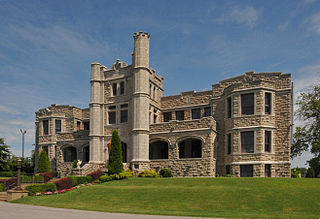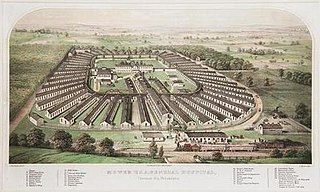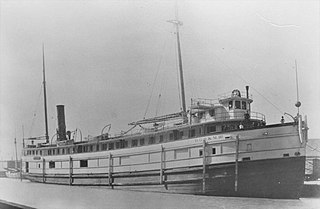
Washburn is a city in Washburn Township, Barry County, Missouri, United States. The current town encompasses the sites of two communities formerly known as Keetsville and O'Day and is named for local pioneer Samuel C. Washburn. The population was 435 at the 2010 census.

Springfield is the third largest city in the U.S. state of Missouri and the county seat of Greene County. As of the 2020 census, the city's population was 169,176. It is the principal city of the Springfield metropolitan area, which has an estimated 2021 population of 481,483 and includes the counties of Christian, Dallas, Greene, Polk, and Webster, and is the fastest growing metropolitan area in the state of Missouri.

The Knights of Pythias is a fraternal organization and secret society founded in Washington, D.C., on February 19, 1864. The Knights of Pythias is the first fraternal organization to receive a charter under an act of the United States Congress. It was founded by Justus H. Rathbone, who had been inspired by a play by the Irish poet John Banim about the legend of Damon and Pythias. This legend illustrates the ideals of loyalty, honor, and friendship that are the center of the order.

College of the Ozarks is a private Christian college in Point Lookout, Missouri. The college has an enrollment of 1,426 and over 30 academic majors in Bachelor of Arts and Bachelor of Science programs.
Evangel University is a private Christian university and seminary in Springfield, Missouri. It is affiliated with the Assemblies of God Christian denomination, which is also headquartered in Springfield. The campus sits on 80 acres that were originally part of O'Reilly General Hospital.

The Pythian Home of Missouri, also known as Pythian Castle, in Springfield, Missouri, was built in 1913 by the Knights of Pythias and later owned by the U.S. military. German and Italian prisoners-of-war were assigned here during World War II for medical treatment and as laborers. Some prisoners were kept in the detached powerhouse and laundry room behind the castle. The laundry room is still owned by the U.S. Army.

Brooke Army Medical Center (BAMC) is the United States Army's premier medical institution. Located on Fort Sam Houston, BAMC, a 425-bed Academic Medical Center, is the Department of Defense's largest facility and only Level 1 Trauma Center. BAMC is also home to the Center for the Intrepid, an outpatient rehabilitation facility. The center is composed of ten separate organizations, including community medical clinics, centered around the Army's largest in-patient hospital. BAMC is staffed by more than 8,000 Soldiers, Airmen, Sailors, Civilians, and Contractors providing care to wounded Service Members and the San Antonio Community at-large.

The Springfield, Missouri, metropolitan area, as defined by the United States Census Bureau, is an area consisting of five counties in southwestern Missouri, anchored by the city of Springfield, the state's third largest city. Other primary population centers in the metro area include Nixa, Ozark, Republic, Bolivar, Marshfield and Willard. Currently, the city limits of Springfield reach the Ozark city limits at the Christian County line on US 65, the city limits of Republic at James River Freeway on the southwest side of the city, and the Strafford city limits on Route 744 on the northeast side of the city.

Mower General Hospital was one of the largest Federal military hospitals during the American Civil War. Located across from the Reading Railroad depot in the Chestnut Hill section of Philadelphia, it operated from January 1863 through May 1865, and was closed with the cessation of the war.
McDonald Army Health Center is a military treatment facility at Fort Eustis in Virginia.
The University of Missouri School of Medicine is located in the southern part of the University of Missouri campus in Columbia, Missouri. It was the first publicly supported medical school west of the Mississippi River.
Fort Leonard Wood is a U.S. Army training installation located in the Missouri Ozarks. The main gate is located on the southern boundary of The City of St. Robert. The post was created in December 1940 and named in honor of General Leonard Wood in January 1941. Originally intended to train infantry troops, in 1941 it became an engineer training post with the creation of the Engineer Replacement Training Center. During World War II Italian and German POWs were interned at the fort. In 1984, as part of the Base Realignment and Closure process, most of the U.S. Army Engineer School's operations were consolidated at Fort Leonard Wood. Before that, officer training was conducted at Fort Belvoir, Virginia.

George O. Wood was an American Pentecostal minister. He served in executive leadership of the U.S. Assemblies of God for 24 years in the roles of general secretary and general superintendent. From 2007 until 2017, he served as General Superintendent of the General Council of the Assemblies of God in the United States of America (AG) and had been Chairman of the World Assemblies of God Fellowship, the largest Pentecostal denomination in the world, since 2008. He previously served as General Secretary of the AG from 1993 to 2007.
George S. Phalen was an American hand surgeon remembered for his work on carpal tunnel syndrome including his description of Phalen's maneuver.

The state of medical knowledge at the time of the Civil War was extremely primitive. Doctors did not understand infection, and did little to prevent it. It was a time before antiseptics, and a time when there was no attempt to maintain sterility during surgery. No antibiotics were available, and minor wounds could easily become infected, and hence fatal. While the typical soldier was at risk of being hit by rifle or artillery fire, he faced an even greater risk of dying from disease.

Springfield-Greene County Library District (SGCL) is a library system that operates in both Springfield, Missouri and Greene County, Missouri. Springfield and Greene County Libraries operated as separate entities until 1961, when the Greene County Library board began contracting services from the Springfield Public Library. Boards from both the Springfield Public Library and the Greene County Library decided that it would be more effective to operate as one entity and merged in 1971 becoming the Springfield-Greene County Library District.

The Wisconsin was an iron-hulled package steamer built in 1881 that sank in 1929 in Lake Michigan off the coast of Kenosha, Wisconsin, United States. In 2009 the shipwreck site was added to the National Register of Historic Places.

The Battle of Dug Springs, also known as the Rains Scare, was a battle that was a part of the Trans-Mississippi Theater of the American Civil War. It was fought on August 2, 1861, near Clever, Missouri.

U.S. Army General Hospital No. 1, also known as Columbia War Hospital, was a World War I era field hospital built by Columbia University on the Columbia Oval property in Norwood, The Bronx. The hospital was used as a medical training facility, a model for military field hospitals, and for long-term treatment of patients.
















